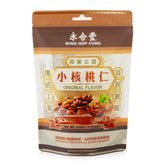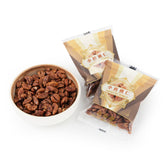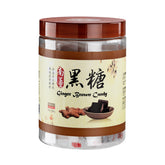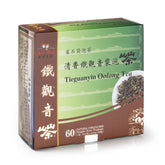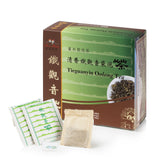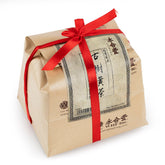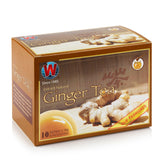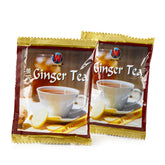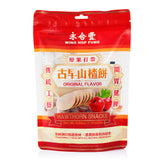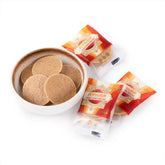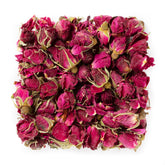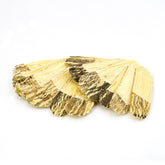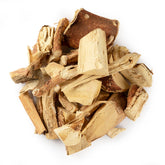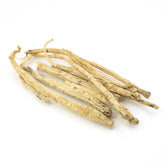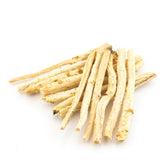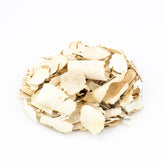Traditional Herbal

-
【Benefits】 Red beans are rich in dietary fiber, which can promote intestinal peristalsis, prevent constipation, and help with detoxification. They are also effective in diuresis and detumescence, which can relieve edema. In addition, red beans have the function of invigorating the spleen and stomach,...
- $4.99
- $4.99
- Unit price
- per
-
决明子/草决明(16oz) 性味 咸苦;平凉;无毒 功效 为豆科植物决明和小决明的成熟种子。 清肝,明目,利水,通便。主治风热赤眼,青盲,雀目,高血压,肝炎,肝硬化腹水,习惯性便秘。 经脉 肝经;胆经;肾经 注意禁忌 泄泻和血压低者慎用。 食疗方 菊花决明粥 取白菊花、草决明各10克,大米100克,冰糖少许。将草决明炒香,与菊花同煎取汁,放入大米煮成稀粥,待熟后调入冰糖,再稍煮即可。每日服食1次。 此粥可清肝、明目、降压,还可治疗目赤肿痛、怕光流泪、头痛头晕、大便秘结等。 决明苁蓉蜂蜜茶 炒决明子、肉苁蓉各10 g,蜂蜜适量。将决明子、肉苁蓉共入茶杯中,沸水冲泡,盖焖10分钟,调入蜂蜜适量即成。代茶频饮。 功效:润肠通便。主治习惯性便秘和老年性便秘。 山楂决明荷叶汤 山楂、决明子各15g,荷叶半张。山楂切片,荷叶切丝,与决明子加水共煎。取汁代茶饮 功效 适用于冠心病、高血压、高血脂、肥胖症等。决明子能抑制血清胆固醇的升高,抑制主动脉粥样硬化斑块的形成,其水浸液具有降压作用。荷叶有止渴、散瘀血、助脾胃、消水肿等功效,与山楂合用,可祛脂降压,减肥健身,为高血压之头晕目眩等症之药膳良方。 Cassia Seed / Jue Ming Zi (16oz) Jue Ming Zi is adored by many women as it aids weight loss....
- $7.99
- $7.99
- Unit price
- per
-
【Benefits】 Sea coconut, also known as Nypa fruticans fruit, offers several health advantages. It is highly effective in moistening the lungs and relieving coughs, providing relief for dry coughs and respiratory discomfort. It can also promote body fluid production to quench thirst, alleviating dryness...
- $6.99
- $6.99
- Unit price
- per
-
【Benefits】 Snow lotus seeds are believed to have multiple health benefits. They can effectively moisten the lungs and relieve coughs, providing relief for respiratory discomfort. They also possess the function of nourishing the kidneys and strengthening the body, which may help improve physical weakness...
- $19.49
- $19.49
- Unit price
- per
-
【Benefits】 Black beans are rich in dietary fiber, which can promote intestinal peristalsis, prevent constipation, and aid in detoxification. They also have diuretic effects, helping to relieve edema and maintain fluid balance in the body. Additionally, black beans are known for nourishing the kidneys...
- $5.99
- $5.99
- Unit price
- per
-
山东平阴 大红玫瑰花 #1107 Chinese Rose Tea is made from buds specially selected and handpicked when they are young in order to preserve the natural shape of the flowers when being dried. As a result they retain the full flavors and aroma within each rosette, emanating...
- from $15.99
- from $15.99
- Unit price
- per
-
熟薏米 (8oz) 熟薏苡仁(薏米) 一般配搭生薏米,能夠中和生薏苡仁的寒性。生薏米主力「利水」,熟薏米主力「健脾」兩者合用才能達到真正去水腫、去濕和健脾,適合大部分人的體質。 生薏米、熟薏米、洋薏米区分: 生薏米: 屬性偏寒。禾本科植物薏苡的乾燥成熟種仁。顏色灰白,圓形,質地堅硬,有一條寬而深的縱溝。 功效:利水袪濕,袪濕力較其他薏米強。 熟薏米: 屬性平和。經炒製後的熟薏仁形狀較生薏仁大,呈灰白色,質感較鬆散及輕。 功效:補脾止瀉,補脾力較好。 洋薏米: 屬性為涼。是磨去殼皮的大麥,狀如白米粒,呈灰黃色。 功效:只是食物,但含豐富纖維,有助腸道蠕動。 Cooked Coix Seed / Shou Yi Mi(8 oz) Cooked Coix Seed is generally paired with raw Coix Seed to neutralize the coldness of raw Coix Seed. The main use of...
- $6.99
- $6.99
- Unit price
- per
-
【Benefits】 In traditional Chinese medicine, Astragalus is renowned for its effects of tonifying qi and lifting yang, consolidating the exterior to stop sweating, promoting diuresis to reduce edema, and promoting tissue regeneration to close sores. It effectively alleviates symptoms like qi deficiency fatigue, spontaneous...
- from $15.99
- from $15.99
- Unit price
- per
-
【Benefits】 In traditional Chinese medicine, Huai Shan (Chinese yam, Dioscorea opposita) is valued for its effects of tonifying the spleen and stomach, promoting fluid production and nourishing the lung, and tonifying the kidney and securing essence. It effectively alleviates symptoms like poor appetite, loose...
- $28.99
- $28.99
- Unit price
- per
-
【Benefits】 In traditional Chinese medicine, Ficus hirta (Five-fingered Fig Root) is valued for its effects of strengthening the spleen and resolving dampness, promoting qi and resolving phlegm, relaxing tendons and activating collaterals. It effectively alleviates symptoms like poor appetite, loose stools due to spleen...
- $9.99
- $9.99
- Unit price
- per
-
【Benefits】 Pearl barley can remove dampness and strengthen the spleen. It is helpful in alleviating the symptoms of heaviness and fatigue in the body caused by excessive dampness. It also has the effect of promoting diuresis and reducing swelling, which is beneficial for improving...
- $7.99
- $7.99
- Unit price
- per
-
【Benefits】In traditional Chinese medicine, Codonopsis pilosula (Dangshen) is renowned for its effects of replenishing middle qi, invigorating the spleen and benefiting the lung. It effectively alleviates symptoms like qi deficiency-induced fatigue, poor appetite, loose stools, lung qi deficiency-caused cough with little phlegm, and shortness...
- $28.99
- $28.99
- Unit price
- per
-
【Benefits】 In traditional Chinese medicine, Glehnia littoralis (North Sand Ginseng) is valued for its effects of nourishing yin to clear the lung, benefiting the stomach to promote fluid production. It effectively alleviates symptoms like dry cough with little sputum due to lung heat, sore...
- $12.99
- $12.99
- Unit price
- per
-
【Benefits】In traditional Chinese medicine, Rehmannia glutinosa (Shu Di Huang, Prepared Rehmannia Root) is renowned for its effects of nourishing blood and yin, replenishing essence and marrow. It effectively alleviates symptoms like blood deficiency-induced pale complexion, dizziness, irregular menstruation, and yin deficiency-caused night sweats, dry...
- $7.99
- $7.99
- Unit price
- per
-
【Benefits】 In traditional Chinese medicine, Poria cocos (Fu Ling) is renowned for its effects of promoting diuresis to eliminate dampness, strengthening the spleen, and calming the mind. It effectively alleviates symptoms like edema, oliguria caused by dampness retention, poor appetite, loose stools due to...
- $14.99
- $14.99
- Unit price
- per
-
【Benefits】 In traditional Chinese medicine, Fritillaria cirrhosa (Chuan Bei Mu) is highly valued for its effects of clearing heat and moistening the lung, resolving phlegm and relieving cough, dissipating nodules and reducing abscesses. It effectively alleviates symptoms like dry cough with little sputum, bloody...
- $16.99
- $16.99
- Unit price
- per
-
大花 夏枯草(8oz/包) 又名夏枯球、枯草头、枯草穗 、夏枯头、夏枯花、铁色草、麦夏枯、棒槌草、 锣锤草、 牛牯草、广谷草、 棒头柱、古牛草 本品为唇形科植物夏枯草的干燥果穗。 性味:苦辛,寒。 经脉:入肝经、胆经。 主治:清肝,散结。治瘰疬,瘿瘤,乳痈,乳癌,目珠夜痛,羞明流泪,头目眩晕,口眼歪斜,筋骨疼痛,肺结核,急性黄疸型传染性肝炎,血崩,带下。 注意禁忌:脾胃虚弱者慎服。 【食疗方】 夏枯草煲猪肉 夏枯草20克,瘦猪肉50克,猪肉切薄片,小火炖汤,每天服2次。 此药膳清肝热,滋阴补虚,可治虚症型高血压病。 Fruit-spike of Common Selfheal/Prunella/Xia Ku Cao (8 oz/bag) Cooling, detoxifying, soothing, mild tasting: Prunella vulgaris is a medicinal herb that has been used for centuries to treat infections...
- $11.99
- $11.99
- Unit price
- per
-
【Benefits】 In traditional Chinese medicine, Smilax glabra (Tu Fu Ling) is valued for its effects of detoxifying, eliminating dampness, and unblocking the joints. It effectively alleviates symptoms like sores and carbuncles due to toxin accumulation, skin itching from damp-heat, joint pain and stiffness caused...
- $11.99
- $11.99
- Unit price
- per
-
霸王花(8oz) 为仙人掌科植物量天尺的花。 性味 甘;性微寒 功效 为仙人掌科植物量天尺的花。用于肺热咳嗽,肺痨,瘰疬,痄腮。 经脉 肺经 霸王花猪肉汤 原料 霸王花50克(1两),猪肉400克(8两),粉肠150克(3两),蜜枣4粒,南北杏2汤匙。 做法 1.粉肠切去肥油,将4粒蜜枣放入粉肠内,在粉肠另一端摧出,洗净出水过冷河。 2.猪肉放落滚水中,煮5分钟取起洗净。 3.霸王花用清水浸软,洗净抹干水,切短度。 4.把适量清水煲滚,放下全部材料猛火煲滚,再用慢火煲3小时,下盐调味。 功效 此汤清凉健肺去痰火,清热气。 Lily Flowder/ Ba Wang Hua (8 oz) Sold in dried form, ba wang hua (dried night-blooming cereus) is a flower that is used in traditional...
- $9.99
- $9.99
- Unit price
- per
-
【Benefits】 Black plums can astringe the intestines and stop diarrhea, helping to relieve symptoms of loose stools and dysentery. They have the effect of promoting the production of body fluids and quenching thirst, making them useful for alleviating dry mouth and thirst. Additionally, black...
- $4.99
- $4.99
- Unit price
- per

